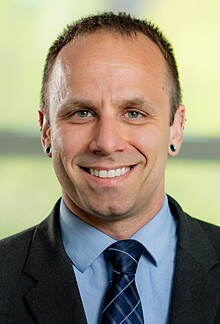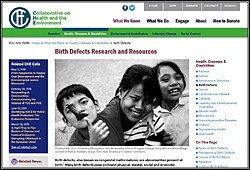Blog
Post category: birth defects
2018
What’s new
Meet our 20 Pioneers under 40 in Environmental Public Health: Kelly Ferguson, PhD, MPH
 Kelly Ferguson, PhD, MPH, is an NIH researcher whose focus is looking at how different exposures impact birth outcomes. Her interest in environmental health comes from the fact that it’s something that everyone deals with.
Kelly Ferguson, PhD, MPH, is an NIH researcher whose focus is looking at how different exposures impact birth outcomes. Her interest in environmental health comes from the fact that it’s something that everyone deals with.
“It’s a concern that affects everyone and that everyone can kind of wrap their head around… people are often thinking about what chemicals are going into their body, what chemicals are in their air, what chemicals are in the food that they are eating, and so I think it’s something that is really easy to communicate with everyone about,” Dr. Ferguson says.
Her work is also looking at oxidative stress, most specifically as it relates environmental exposures in women and preterm birth. . . .
2018
What’s new
Webinars
Meet our 20 Pioneers under 40 in Environmental Public Health: Joseph Braun, PhD, MSPH
 Joseph Braun, PhD, MSPH spends his time figuring out how things that children come into contact with even before they are born can have an impact later in their lives.
Joseph Braun, PhD, MSPH spends his time figuring out how things that children come into contact with even before they are born can have an impact later in their lives.
“We are focused on understanding how early life environmental exposures influence children’s growth and development. We are considering the early life window now to extend from before conception in both the mother and the father, during the prenatal period in the mother, when the baby is in the womb, and the postnatal period from infancy onward till adolescence. So, we are looking at a wide range of environmental chemical exposures and how they influence children’s risk of neurobehavioral disorders like ADHD or autism as well as their risk of becoming obese or overweight. And, even how environmental factors might influence their metabolism of things like glucose or lipids. Finally, we are also trying to understand some of the biologic mechanisms that underlie these associations,” Dr. Braun says. . . .
2017
What’s new
Just released! Protecting Children’s Health Where They Live, Learn, and Play.
This report from the NIEHS/EPA Children’s Environmental Health and Disease Prevention Centers highlights some of the important contributions the centers have made toward reducing the burden of environmentally induced or exacerbated diseases placed on children. The report provides examples of success in the community and in support of public health. It is organized in three section:
- Health outcomes, presenting scientific findings from the Children’s Centers on diseases that sometimes affect children
- Environmental exposures, presenting research findings on chemicals and pollutants children are commonly exposed to through air, water and food.
- Hallmark features, highlighting the unique features that have facilitated the work of the Children’s Centers and advancements in the field.
2017
What’s new
New Webpage: Birth Defects
 Our new webpage offers an overview of exposures, prevalence, prevention strategies, economic impacts and ethical issues regarding birth defects. Find out more by viewing our web page today!
Our new webpage offers an overview of exposures, prevalence, prevention strategies, economic impacts and ethical issues regarding birth defects. Find out more by viewing our web page today!


